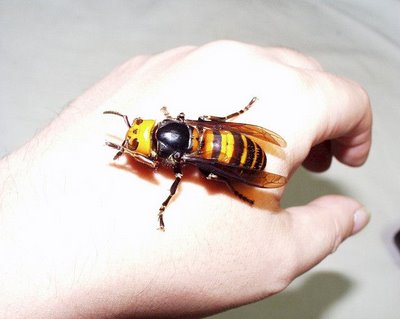
The Asian Giant Hornet grows up to 5.5 cms in length and is found in most of Asia. A vicious predator, its stinger is 6.5mm long (!).
.
"The Japanese giant hornet, Vespa mandarinia japonica, preys on other species of bees and wasps. When a solitary hunter finds a nest, it marks it with a secretion from its van der Vecht gland. Other hornets in the area congregate to the area, and they begin a mass attack on the colony. While they are efficient at wiping out hives of the introduced European honeybee Apis mellifera (If a colony of about 30.000 European honeybees were to be attacked by 30 giant hornets they would be wiped out in 3 hours), the native Japanese honeybee, Apis cerana japonica, has an interesting defense against the predatory hornet. The Japanese honeybees can detect the hornet's secretion, and attack incoming hornets en masse. With approximately 500 honeybees surrounding the hornet in a tight ball, the temperature within the cluster rises to 47º C (117º F), which is above the upper lethal limit range of 44-46 degrees for the hornet. This temperature is too high for the hornet, which quickly expires, but does not harm the honeybees.This temperature does not aversely affect the honeybees because their upper lethal limit is slightly higher, 48-50 degrees."
.
Link.
Via.
.
El Avispon Gigante Asiatico puede llegar a medir 5.5 centimetros de largo y habita en gran parte de Asia. Su aguijon mide 6.5mm (!).
El Avispon gigante Japones, Vespa Mandarinia Japonica (no miento), caza otras especies de abejas y avispas. Cuando un explorador encuentra un enjambre, lo marca con una excrecion de su glandula van der Vercht (famosa en el mundo entero). Otros avispones, como son muy avispados ellos (je je je), se congregan en el area y lanzan un ataque en masa. Mientras que son muy eficientes exterminando colonias enteras de la abeja Europea Apis Mellifera (30 Avispones podrian acabar con 30000 de estas abejas en menos de tres horas a base de arrancarlas la cabeza), las abejas autoctonas del Japon, la Apis Cerana Japonica, tiene un sistema de defensa muy efectivo. Estas abejas, habiendo detectado la excrecion del avispon, se lanzan sobre el intrusor y forman una bola compacta a su alrrededor de hasta 500 abejas. Entonces empiezan a vibrar como locas, y elevan la temperatura en el interior de la bola a 48C, por encima del limite de temperatura que puede soportar el avispon (47C) pero por debajo del de las abejas (50C). El avispon cae asi fulminado.
.
Via.
.

0 comments:
Post a Comment